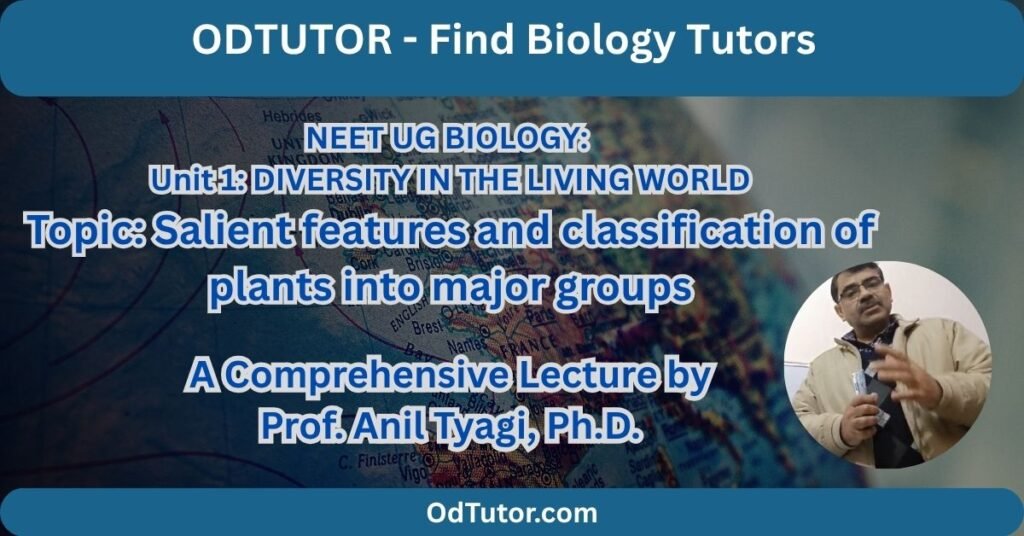Unit 1
A Comprehensive Lecture by Prof. Anil Tyagi, Ph.D.
Welcome, future doctors. A strong grasp of the Plant Kingdom is essential. It forms the basis for understanding plant physiology, genetics, and even pharmacology. The classification we will study today is a reflection of millions of years of evolution, showcasing how plants overcame challenges to conquer terrestrial habitats. We will focus on four major groups: Algae, Bryophytes, Pteridophytes, and Gymnosperms, highlighting their distinguishing features and examples.
Part 1: Understanding the Evolutionary Trends
Before we dive into each group, let’s understand the broad evolutionary trends we will observe as we move from Algae to Gymnosperms:
- Dominant Phase in Life Cycle: A shift from the haploid gametophyte being dominant (in Bryophytes) to the diploid sporophyte being dominant (in Pteridophytes and Gymnosperms).
- Vascular System: The development of specialized tissues for conduction – xylem and phloem. This was a revolutionary step for life on land.
- Reproduction: The evolution from simple spores to the highly advanced seed.
- Water Dependence: A gradual reduction in the dependence on external water for fertilization.
- Structural Complexity: The development of true roots, stems, and leaves.
Keeping these trends in mind will make the features of each group logical and easy to remember.
Part 2: Algae – The Aquatic Pioneers
Algae are the simplest, thalloid organisms that are largely aquatic. They are the foundation of aquatic food chains and are responsible for a significant portion of the Earth’s oxygen production.
Salient and Distinguishing Features:
- Habitat: Primarily aquatic (both freshwater and marine). They are also found in other damp habitats like moist soil, wood, and on stones.
- Plant Body: The body is a thallus, meaning it is not differentiated into true roots, stems, or leaves. They can be unicellular (e.g., Chlamydomonas), colonial (e.g., Volvox), or filamentous (e.g., Ulothrix, Spirogyra).
- Nutrition: They are autotrophic and contain chlorophyll. Different accessory pigments like chlorophyll-b, carotenoids, and xanthophylls give them their characteristic green, red, or brown colour.
- Cell Wall: The cell wall is made of cellulose.
- Reproduction: Can be vegetative (fragmentation), asexual (zoospores), and sexual. Sexual reproduction ranges from isogamy (similar gametes) to oogamy (large non-motile female gamete and small motile male gamete).
- Economic Importance: They are of immense importance. They are a source of food (Laminaria, Porphyra), hydrocolloids like agar (from Gelidium, Gracilaria), and are used in products like toothpaste and ice-cream.
Classification with Examples:
Algae are classified into three main groups based on their pigment composition.
- Chlorophyceae (Green Algae):
- Pigments: Chlorophyll-a and b.
- Storage Product: Starch.
- Cell Wall: Inner layer of cellulose, outer layer of pectose.
- Examples:
- Chlamydomonas (Unicellular, flagellated)
- Volvox (Colonial, forms coenobium)
- Spirogyra (Filamentous, with characteristic spiral chloroplast)
- Ulothrix (Filamentous)
- Phaeophyceae (Brown Algae):
- Pigments: Chlorophyll-a and c, and the brown pigment fucoxanthin.
- Storage Product: Laminarin and Mannitol.
- Plant Body: They possess a simple, root-like holdfast, a stalk-like stipe, and a leaf-like frond. Some are giant, like the kelps.
- Examples:
- Ectocarpus (A branched, filamentous form)
- Fucus (Rockweed)
- Laminaria (Kelp)
- Sargassum (Gulfweed)
- Rhodophyceae (Red Algae):
- Pigments: Chlorophyll-a and d, and the red pigment phycoerythrin.
- Storage Product: Floridean starch.
- Habitat: Mostly marine, found at greater depths than other algae because phycoerythrin can absorb blue light and perform photosynthesis.
- Examples:
- Polysiphonia (A branched, filamentous form)
- Porphyra (Used as food, ‘Nori’ in Japan)
- Gelidium and Gracilaria (Source of Agar)
Part 3: Bryophytes – The Amphibians of the Plant Kingdom
Bryophytes mark the first attempt of plants to colonize land. However, they are not completely free from the need for water, which is why they are called the “amphibians.”
Salient and Distinguishing Features:
- Habitat: They live in damp, shady, and humid places. They require water for fertilization.
- Plant Body: It is thalloid (e.g., Marchantia) or leafy (e.g., Funaria). They lack true vascular tissues (xylem and phloem). They have root-like structures called rhizoids for anchorage.
- Dominant Phase: The main plant body is the haploid gametophyte. It is independent and photosynthetic.
- Sporophyte: The diploid sporophyte is not free-living. It is physically and nutritionally dependent on the gametophyte. It produces haploid spores through meiosis in a capsule.
- Water for Fertilization: The male gamete (antherozoid) is flagellated and motile. It requires a film of water to swim to the female gamete (archegonium).
- Economic Importance: They help in soil formation, prevent soil erosion, and Sphagnum (a moss) is used as a fuel (peat) and in packing material.
Classification with Examples:
Bryophytes are divided into two main classes:
- Liverworts (Hepaticopsida):
- Plant Body: It is a dorsiventral, prostrate, and dichotomously branched thallus.
- Vegetative Reproduction: Takes place by fragmentation or by specialized structures called gemmae (in Marchantia).
- Examples:
- Marchantia (The classic example with gemma cups)
- Riccia
- Mosses (Bryopsida):
- Stages of Development: Their life cycle has two stages:
- Protonema Stage: The first, creeping, green, filamentous stage that develops directly from a spore.
- Leafy Stage: The second, upright, stage that bears sex organs and develops from the protonema.
- Examples:
- Funaria (The “Cord Moss,” a common example)
- Polytrichum
- Sphagnum (Peat Moss)
- Stages of Development: Their life cycle has two stages:
Part 4: Pteridophytes – The First Vascular Plants
Pteridophytes are the first plants to possess a true vascular system (xylem and phloem). This was a monumental leap that allowed them to grow larger and thrive in drier environments.
Salient and Distinguishing Features:
- Vascular Tissues: They are the first plants to have well-developed xylem and phloem.
- Plant Body: It is differentiated into true roots, stems, and leaves.
- Dominant Phase: The main plant body is a diploid sporophyte. It is independent and photosynthetic.
- Gametophyte: The gametophyte is a small, inconspicuous, independent structure called a prothallus. It is free-living, multicellular, and photosynthetic.
- Water for Fertilization: Like bryophytes, they still require water for the motile antherozoids to reach the archegonia.
- Heterospory: A critical evolutionary step seen in some pteridophytes like Selaginella and Salvinia. They produce two kinds of spores: microspores (male) and megaspores (female). This is a precursor to seed habit.
Classification with Examples:
Pteridophytes are classified into four classes, but for NEET, knowing key examples is sufficient.
- Psilotum (Whisk Ferns): A primitive pteridophyte with no true roots or leaves.
- Lycopsida (Club Mosses):
- Examples:
- Selaginella (A heterosporous pteridophyte)
- Lycopodium (Club Moss)
- Examples:
- Sphenopsida (Horsetails):
- Example:
- Equisetum (The Scouring Rush – stems are rough due to silica deposits)
- Example:
- Pteropsida (Ferns):
- Features: They possess large, divided leaves called fronds.
- Examples:
- Dryopteris (A common fern)
- Pteris
- Adiantum (The Maidenhair Fern)
- Salvinia (An aquatic, heterosporous fern)
Part 5: Gymnosperms – The Naked Seed Plants
Gymnosperms represent a major advancement: the development of seeds. However, their seeds are not enclosed in a fruit; they are “naked” and borne on megasporophylls.
Salient and Distinguishing Features:
- Seeds: They produce seeds. This is their most defining feature.
- Naked Seeds: The seeds are not enclosed inside a fruit. They are typically borne on megasporophylls which may be clustered to form cones.
- Vascular Tissues: The vascular system is well-developed. The xylem lacks vessels (has only tracheids) and the phloem lacks companion cells.
- Roots: In some, like Pinus, the roots show a symbiotic association with fungi (mycorrhiza). In Cycas, specialized roots called coralloid roots are associated with nitrogen-fixing cyanobacteria.
- Heterospory: All gymnosperms are heterosporous. They produce microspores and megaspores.
- Reduced Water Dependence: Fertilization involves the formation of a pollen tube to carry the male gametes to the egg cell. This eliminates the need for external water for fertilization.
Classification with Examples:
- Cycadaceae (Cycads):
- Features: They resemble palm trees. They are dioecious (male and female plants are separate).
- Example:
- Cycas (Sago Palm) – A very common NEET example.
- Coniferaceae (Conifers):
- Features: They are the most abundant group of gymnosperms. They are typically tall, evergreen trees with needle-like leaves to reduce water loss.
- Examples:
- Pinus (Pine tree)
- Cedrus (Deodar)
- Sequoia (Redwood – one of the tallest tree species)
- Other Examples:
- Ginkgo (The Maidenhair Tree – it is a living fossil)
- Ephedra (A shrub, source of the drug Ephedrine)
Professor Tyagi’s Key Takeaways for NEET Success:
- The Big Picture: Remember the evolutionary sequence: Algae -> Bryophytes -> Pteridophytes -> Gymnosperms. Focus on the progressive reduction of gametophyte and the development of vascular tissue and seeds.
- Dominant Phase: This is a crucial distinguishing feature.
- Gametophyte Dominant: Bryophytes
- Sporophyte Dominant: Pteridophytes and Gymnosperms
- Water for Fertilization: Required in Bryophytes and Pteridophytes. Not required in Gymnosperms (due to pollen tube).
- Vascular Tissues: Absent in Bryophytes. Present in Pteridophytes and Gymnosperms.
- Seeds: Absent in Algae, Bryophytes, Pteridophytes. Present (Naked) in Gymnosperms.
- Examples are Key: Memorize at least two examples from each group, as direct questions are frequently asked.
Master this logical flow, and you will be able to tackle any comparative question from the Plant Kingdom in your NEET exam.
Your dedication to understanding these fundamental concepts is what will set you apart. Keep striving for excellence.
– Prof. Anil Tyagi

